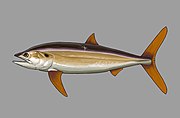| Pachycormiformes Temporal range: Early Jurassic - Late Cretaceous, Toarcian–Maastrichtian PreꞒ Ꞓ O S D C P T J K Pg N | |
|---|---|

| |
| Skeleton of Pachycormus | |

| |
| Skeleton of Orthocormus | |
| Scientific classification | |
| Domain: | Eukaryota |
| Kingdom: | Animalia |
| Phylum: | Chordata |
| Class: | Actinopterygii |
| Infraclass: | Teleosteomorpha |
| Division: | †Aspidorhynchei |
| Order: | †Pachycormiformes Berg 1937 |
| Family: | †Pachycormidae Woodward, 1895 |
| Type genus | |
| Pachycormus Agassiz, 1833 | |
| Genera | |
|
See text | |
| Synonyms | |
| |
Pachycormiformes is an extinct order of marine ray-finned fish known from the Early Jurassic to the end of the Cretaceous. It only includes a single family, Pachycormidae. They were characterized by having serrated pectoral fins (though more recent studies demonstrated that fin shape diversity in this group was high), reduced pelvic fins and a bony rostrum. Pachycormiformes are morphologically diverse, containing both tuna and swordfish-like carnivorous forms, as well as edentulous suspension-feeding forms.
Description

Pachycormiformes are united by "a compound bone (rostrodermethmoid) forming the anterodorsal border of the mouth; a reduced coronoid process of the mandible; absence of supraorbitals associated with a dermosphenotic defining the dorsal margin of the orbit; two large, plate-like suborbital bones posterior to the infraorbitals; long, slender pectoral fins; asymmetrical branching of pectoral fin lepidotrichia; considerable overlap of the hypurals by caudal fin rays (hypurostegy); and the presence of distinctive uroneural-like ossifications of the caudal fin endoskeleton". Pachycormiformes varied substantially in size, from medium-sized fishes around 40–111 centimetres (1.31–3.64 ft) in length like the macropredator Pachycormus, to the largest known ray-finned fish, the suspension feeding Leedsichthys, which is estimated to have reached a maximum length of around 16 metres (52 ft).
Relationships
Pachycormiformes are generally interpreted as basal members of Teleosteomorpha, the group that includes all fish more closely related to modern teleosts than to Holostei (the group containing bowfin and gars), often they have been considered to be the sister group of the Aspidorhynchiformes.
Gallery
-
 Reconstruction of Protosphyraena perniciosa
Reconstruction of Protosphyraena perniciosa
-
 Life restoration of Leedsichthys
Life restoration of Leedsichthys
-
 Life restoration of Ohmdenia
Life restoration of Ohmdenia
-
 Life restoration of Bonnerichthys
Life restoration of Bonnerichthys
-
 Life restoration of Pachycormus
Life restoration of Pachycormus
-
 Life restoration of Orthocormus
Life restoration of Orthocormus
Taxonomy
Taxonomy according to Cooper et al. (2022):
- Euthynotus Wagner, 1860
- Haasichthys Delsate, 1999
- Notodectes Dolgopol de Saez, 1949
- Pseudoasthenocormus
- Sauropsis Agassiz, 1843
- Hypsocorminae Vetter, 1881
- Australopachycormus Kear, 2007
- Hypsocormus Wagner, 1860
- Kaykay Gouiric-Cavalli & Arratia, 2022
- Orthocormus Weitzel, 1930
- Protosphyraena Leidy, 1857
- Simocormus Maxwell et al., 2020
- Asthenocorminae Cooper et al., 2022
- Germanostomus Cooper et al., 2022
- Ohmdenia Hauff, 1953
- Pachycormus? Agassiz, 1833
- Saurostomus Agassiz, 1843
- Suspension-feeding clade
- Asthenocormus Woodward, 1895
- Bonnerichthys Friedman et al., 2010
- Leedsichthys Woodward, 1889
- Martillichthys Liston, 2008
- Rhinconichthys Friedman et al., 2010
Cladistics according to Friedman et al. (2010).
| Pachycormiformes |
| ||||||||||||||||||||||||||||||||||||||||||||||||||||||||||||||||||
References
- van der Laan, R. (2018). "Family-group names of fossil fishes". European Journal of Taxonomy (466). doi:10.5852/ejt.2018.466.
- Liston, Jeff J.; Maltese, Anthony E.; Lambers, Paul H.; Delsate, Dominique; Harcourt-Smith, William E. H.; Heteren, Anneke H. van (2019-11-07). "Scythes, sickles and other blades: defining the diversity of pectoral fin morphotypes in Pachycormiformes". PeerJ. 7: e7675. doi:10.7717/peerj.7675. ISSN 2167-8359. PMC 6842561. PMID 31720097.
- Dobson, Claire; Giles, Sam; Johanson, Zerina; Liston, Jeff; Friedman, Matt (2019-09-03). "Cranial osteology of the Middle Jurassic (Callovian) Martillichthys renwickae (Neopterygii, Pachycormiformes) with comments on the evolution and ecology of edentulous pachycormiforms". Papers in Palaeontology. 7: 111–136. doi:10.1002/spp2.1276. hdl:2027.42/167090. ISSN 2056-2802. S2CID 202919395.
- Gouiric-Cavalli, Soledad; Cione, Alberto Luis (2015-07-04). "Notodectes is the first endemic pachycormiform genus (Osteichthyes, Actinopterygii, Pachycormiformes) in the Southern Hemisphere". Journal of Vertebrate Paleontology. 35 (4): e933738. doi:10.1080/02724634.2014.933738. hdl:11336/13733. ISSN 0272-4634.
- Liston, J., Newbrey, M., Challands, T., and Adams, C., 2013 (2013). "Growth, age and size of the Jurassic pachycormid Leedsichthys problematicus (Osteichthyes: Actinopterygii)" (PDF). In Arratia, G., Schultze, H. and Wilson, M. (ed.). Mesozoic Fishes 5 – Global Diversity and Evolution. München, Germany: Verlag Dr. Friedrich Pfeil. pp. 145–175. ISBN 9783899371598.
{{cite book}}: CS1 maint: multiple names: authors list (link) CS1 maint: numeric names: authors list (link) - Peskin, Brianna; Henke, Katrin; Cumplido, Nicolás; Treaster, Stephen; Harris, Matthew P.; Bagnat, Michel; Arratia, Gloria (2020-07-20). "Notochordal Signals Establish Phylogenetic Identity of the Teleost Spine". Current Biology. 30 (14): 2805–2814.e3. doi:10.1016/j.cub.2020.05.037. ISSN 0960-9822. PMC 8159021. PMID 32559448.
- Arratia, Gloria (2017-03-04). "New Triassic teleosts (Actinopterygii, Teleosteomorpha) from northern Italy and their phylogenetic relationships among the most basal teleosts". Journal of Vertebrate Paleontology. 37 (2): e1312690. doi:10.1080/02724634.2017.1312690. ISSN 0272-4634.
- ^ Cooper, S. L. A.; Giles, S.; Young, H.; Maxwell, E. E. (2022). "A New Large †Pachycormiform (Teleosteomorpha: †Pachycormiformes) from the Lower Jurassic of Germany, with Affinities to the Suspension-Feeding Clade, and Comments on the Gastrointestinal Anatomy of Pachycormid Fishes". Diversity. 14 (12): 1026. doi:10.3390/d14121026.
- Gouiric-Cavalli, S.; Arratia, G. (2022). "A new †Pachycormiformes (Actinopterygii) from the Upper Jurassic of Gondwana sheds light on the evolutionary history of the group". Journal of Systematic Palaeontology. 19 (21): 1517–1550. doi:10.1080/14772019.2022.2049382. S2CID 248454343.
- Matt Friedman; Kenshu Shimada; Larry D. Martin; Michael J. Everhart; Jeff Liston; Anthony Maltese; Michael Triebold (2010). "100-million-year dynasty of giant planktivorous bony fishes in the Mesozoic seas". Science. 327 (5968): 990–993. Bibcode:2010Sci...327..990F. doi:10.1126/science.1184743. PMID 20167784. S2CID 206524637.
| Taxon identifiers | |
|---|---|
| Pachycormiformes | |




